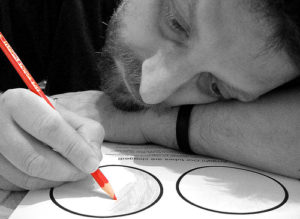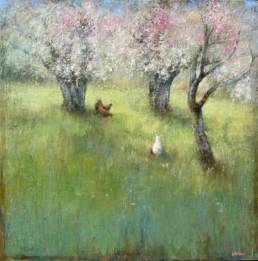 Descartes, the father of Modern Philosophy once so famously said, “I think, therefore I am.” However, if you are an artist, then you probably can more easily empathize with the phrase, “I create, therefore I procrastinate.”
Descartes, the father of Modern Philosophy once so famously said, “I think, therefore I am.” However, if you are an artist, then you probably can more easily empathize with the phrase, “I create, therefore I procrastinate.”
Although other occupations and hobbies are susceptible also to the procrastination blues, there’s something about creative work that lends itself easily to, for a lack of a better way of putting it, goofing around.
As a self-proclaimed artist (what is a wordsmith if not an artist?), I know precisely how it goes. You get out your tools—pen, paper, paintbrush, etc.—and you make a grand show of finally beginning your magnum opus. Then you think. Then you wait. Then you stare. Then you get out your iPhone and stalk your ex on Facebook or you play Angry Birds. Before you know it, it’s time to meet your friends out for a drink.
If this scenario sounds familiar, then here are a few tips for procrastinating artists that have helped me alleviate a bad case of procrastinitis.
1. Create an environment conducive to creating.
I know this sounds fairly obvious, but when I suggest that artists create a pleasant work environment, I don’t just mean clearing your desk of old Chinese takeout boxes. Your work of art will only be as good as the conditions under which you create. As such, it is important that you put some thought into your work space. I was amazed what a change of lighting and rearrangement of furniture could do for my motivation. And you don’t even have to have a tidy workspace, as Francis Bacon can attest.
2. Get in the rhythm.
There’s a rhythm not just in music but in everything in life as well, and that includes work. I’m sure you are familiar with the terms “getting into the zone” or “getting your groove on”, and while the muse is more on the myth side, establishing a rhythm is certainly not an urban legend. While you may have to set up a schedule to ensure that you work on your project consistently, don’t make it so strict that you end up failing and disappointing yourself and procrastinating. Do set aside a daily, weekly, and monthly or project-by-project timeline, but make it flexible.
3. Inspire yourself.
While we can sit around all day waiting for the muse to inspire us, remember that this supposed muse resides within ourselves, as corny as that sounds. You know yourself more than anyone in this world, and you know precisely what external stimuli stimulate your creative capacity. Whatever it is that gets going—whether it’s watching a movie, listening to music, or going to the museum—actively seek it out and make time for it. Activities such as these are definitely not time wasters, so go out there and find the inspiration you need to get started.
4. Minimize distractions.
Especially in the 21st century, distractions are a dime a dozen. Do your best to set aside a time and place for those distractions so you can get your fix, then establish a distraction-free zone in which you put away the Internet, the smart phone, and send your kids out to play. Since people can be just as distracting as technology, make it clear to all that even though you are engaging in the infinitely fun activity of creating art, you are also doing serious work.
Guest author: Barbara Jolie. She welcomes your comments at her email: barbara.jolie876@gmail.com.
I hope to meet you on Twitter and Facebook and Google Plus…and here is my website to view my paintings. ~Lori
photo from http://www.photoree.com/








Great tips, time to get into gear. Thanks again for another great post, Lori!
Thanks Maria, I am so glad you are enjoying this blog. Happy New Year!
Lori 🙂
Lori your bird drawings are beautiful, sensitively rendered, and true to the look and feel of each of the birds. Look forward to seeing more.
Best Regards,
Cindy
Green Leaf Studios
Great tips to keep me on task. Now I’m getting off this computer and getting to work.
Good idea Gayle…I am going to get off of the computer now too! I just finished up painting for a show and I am now waiting for a muse myself…
Thanks for the comment!
Lori
Great tips, Lori !!!
Thanks a lot, and congrats to your blog, it is trully well made of !!!
Barbara, I love this idea of “rhythm.”
All of life is in motion and when we step into that place, good things happen.
In the spirit of rhythm, one of my private clients once told me that, when things weren’t flowing for her, she deliberately started moving her body (in any way she felt like it) and let her paint brush be an extension of that movement until something started to happen. For her, it worked every time!
Hello Ariane,
It’s great to see you here…thanks for contributing your thoughts. I often listen to music while I paint as well. The rhythm helps me too! Good luck with this year’s smartist workshop. 🙂
Happy New Year-
Lori
Why wait for the muse? If I waited for the muse to show up, I’d be waiting a long time.
I don’t wait , I show up in my studio and the work begins. I have a list of subjects and projects
a mile long to do. I believe also that talent is highly overrated, one should just get busy.
Real artists always have some project to execute. I ain’t one to wait for no muse to show up.
See my website http://www.freewebs.com and my blog http://www.Artlife 1.
I am on you tube also.
Waiting forthe muse ,indeed.
Bob, thanks for sharing your counter points here. I sure don’t have time to wait around for a muse either! There are many times when I have to push and work through creative block…breaking that inertia usually helps me find the muse. Thanks for the visit and I will check out your sites.
Happy creating-
Lori
I love creating on the computer so much that it distracts me from sewing to make things (and cleaning house.
Ouch, this is me. Except my ex is not living. 😮 no I did not kill him. LOL
Thank you for a great article.
This is Great Advice to those of us who Know we need to Produce something. I think what helped me most was as you say get in the rhythm or how I put it I feel naked if I do not do it. lol
Thanks Barbra and Lori
So happy to help inspire you Juanita,
Thank you for the comment!
Lori
Thanks for this post. The computer is my greatest distraction! Especially when there are social media sites and blogging to engage in as part of ‘work’ – the hours in my studio keep diminishing from all these other ‘must do’s’. Fiona (www.fionacampbellart.co.uk)
Hi Fiona,
You are welcome…and I share your same distraction! In fact, here I am on it right now – lol. Learning how to manage our time is the key to juggling all we have to do. Good luck and thanks for stopping by.
Lori
Excellent post by Barbara, thanks for sharing it Lori! I write about productivity and creative work at my website, and one of the biggest positive reactions I’ve received from anything on that site was to the idea of schedule-chunking: setting aside blocks of time routinely for different kinds of creative work, which is much the same as Barbara’s #2 heading. It really, honestly works.
Hi Annie, yes this has been a fun post and helpful to others. I like your schedule chunking idea, thanks for the additional input!
Thanks again,
Lori
This post is very important to me, thank you! I have procrastinated way too long and will remain dedicated to creating my landscape drawings. So far I have developed a routine of meditating, journaling and spending an hour a day drawing. You inspire me and thank you!
So glad you enjoyed this post, Katie. Thank you for letting me know!
Here’s to finding your muse-
Lori
These are all so helpful. I am so glad I found your blog. Lori! So right on and in sync with who I am. Great work!
Thank Nikki, glad these tips helped you…
thanks for tips, …..it is so helpful ,,,……
🙂 Thank you!